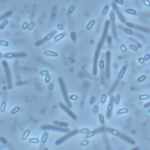Link to Pubmed [PMID] – 29895635
MBio 2018 Jun;9(3)
is the major etiologic agent of antibiotic-associated intestinal disease. Pathogenesis of is mainly attributed to the production and secretion of toxins A and B. Unlike most clostridial toxins, toxins A and B have no signal peptide, and they are therefore secreted by unusual mechanisms involving the holin-like TcdE protein and/or autolysis. In this study, we characterized the cell surface protein Cwp19, a newly identified peptidoglycan-degrading enzyme containing a novel catalytic domain. We purified a recombinant His-tagged Cwp19 protein and showed that it has lytic transglycosylase activity. Moreover, we observed that Cwp19 is involved in cell autolysis and that a mutant exhibited delayed autolysis in stationary phase compared to the wild type when bacteria were grown in brain heart infusion (BHI) medium. Wild-type cell autolysis is correlated to strong alterations of cell wall thickness and integrity and to release of cytoplasmic material. Furthermore, we demonstrated that toxins were released into the extracellular medium as a result of Cwp19-induced autolysis when cells were grown in BHI medium. In contrast, Cwp19 did not induce autolysis or toxin release when cells were grown in tryptone-yeast extract (TY) medium. These data provide evidence for the first time that TcdE and bacteriolysis are coexisting mechanisms for toxin release, with their relative contributions depending on growth conditions. Thus, Cwp19 is an important surface protein involved in autolysis of vegetative cells of that mediates the release of the toxins from the cell cytosol in response to specific environment conditions.-associated disease is mainly known as a health care-associated infection. It represents the most problematic hospital-acquired infection in North America and Europe and exerts significant economic pressure on health care systems. Virulent strains of generally produce two toxins that have been identified as the major virulence factors. The mechanism for release of these toxins from bacterial cells is not yet fully understood but is thought to be partly mediated by bacteriolysis. Here we identify a novel peptidoglycan hydrolase in , Cwp19, exhibiting lytic transglycosylase activity. We show that Cwp19 contributes to cell autolysis in the stationary phase and, consequently, to toxin release, most probably as a response to environmental conditions such as nutritional signals. These data highlight that Cwp19 constitutes a promising target for the development of new preventive and curative strategies.
